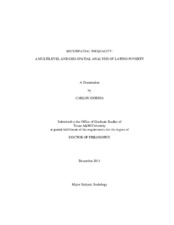| dc.description.abstract | Sociology at its core has always been interested in understanding how society works. Previous studies on social stratification have sought to outline who gets what, when, and why. This project introduces the where element to advance our understanding of how resource distribution affects life chances.
The research question is: Does the percent of Latinos in the area of residence have an influence on Latino?s individual poverty over and above the influence on poverty of the person characteristics? The study ascertains how micro-level inequality is influenced by macro-level attributes and explores how spatial non-stationarity plays a role in these mechanics. This sociospatial inequality investigation will delineate how individual-level stratifying mechanisms are influenced by context-level structural attributes and how sociospatial non-stationary processes play a role in these mechanics.
The dissertation is conceptually driven by Hubert M. Blalock's 1970 theory on minority relationships. Blalock posited the testable hypothesis that discrimination against oppressed groups increases when their population rises. Using theoretical propositions inspired by Blalock leads to the testing of the following two formal hypothesis: the multilevel hypothesis (H1) focuses on macro-level effects, I hypothesize that as the percent of Latinos/as in the area of residence increases, the odds of being in poverty will increase for Latinas/os; on the spatial hypothesis (H2), I hypothesize that the statistical association between percent Latina/o and percent poverty is spatially nonstationary.
I find that H1 cannot be falsified. The models reveal, as Blalock predicted, that as the percent of Latinos/as in the area of residence increases, the odds of being in poverty increase for Latinas/os (even after controlling for various level-1, level-2, and GWR-level-2 factors). I also find that H2 could not be falsified. I find that the statistical association between percent Latina/o and percent poverty is spatially nonstationary.
My multilevel and spatial modeling investigation was unable to falsify Blalock's minority group threat theory. Hierarchical models indicate that as the percent of Latino/a increases, the likelihood of being in poverty for Latinas/os increases. This statically significant relationship holds constant even after spatial nonstationarity level-2 control factors are introduced. | en |


